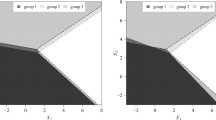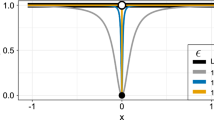Abstract
The location model is a familiar basis for discriminant analysis of mixtures of categorical and continuous variables. Its usual implementation involves second-order smoothing, using multivariate regression for the continuous variables and log-linear models for the categorical variables. In spite of the smoothing, these procedures still require many parameters to be estimated and this in turn restricts the categorical variables to a small number if implementation is to be feasible. In this paper we propose non-parametric smoothing procedures for both parts of the model. The number of parameters to be estimated is dramatically reduced and the range of applicability thereby greatly increased. The methods are illustrated on several data sets, and the performances are compared with a range of other popular discrimination techniques. The proposed method compares very favourably with all its competitors.
Similar content being viewed by others
References
Aitchison J. and Aitken C.G.G. 1976. Multivariate binary discrimination by the kernel method. Biometrika 63: 413–420.
Anderson J.A. 1972. Separate sample logistic discrimination. Biometrika 59: 19–35.
Anderson T.W. 1984. An Introduction to Multivariate Statistical Analysis, 2nd ed. Wiley, New York.
Asparoukhov O.K. 1985. Microprocessor system for investigation of thromboembolic complications. Unpublished Ph.D. dissertation, Technical University, Sofia (in Bulgarian).
Asparoukhov O.K. and andreev Tz. 1995. Comparison of one-stage classifiers for assessment of the ability of children to construct grammatical structures consciously. In: Philosophic to Technical, Panchev I. (Ed.), Multivariate Analysis in the Behavioral Sciences. Academic Publishing House, Sofia, pp. 1–13.
Asparoukhov O.K. and Danchev S. 1997. Discrimination and classification in the presence of binary variables. Biocybernetics and Biomedical Engineering, 17(1-2): 25–39.
Breiman L., Friedman J.H., Olshen R.A., and Stone C.J. 1984. Classification and Regression Trees. Wadsworth, Belmont, CA.
Celeux G. and Mkhadri A. 1992. Discrete regularized discriminant analysis. Statistics and Computing 2: 143–151.
Daudin J.J. 1986. Selection of variables in mixed-variable discriminant analysis. Biometrics 42: 473–481.
Friedman J.H. 1989. Regularized discriminant analysis. Journal of the American Statistical Association 84: 165–175.
Gill P.E., Murray W., and Wright M.H. 1981. Practical Optimization. Academic Press, London.
Habbema J.D.F., Hermans J., and van Den Broek K. 1974. A stepwise discriminant analysis program using density estimation. In: Bruckmann G. (Ed.), Compstat. Physica Verlag, Vienna, pp. 101–110.
Habbema J.D.F., Hermans J., and Remme J. 1978. Variable kernel density estimation in discriminant analysis. In Corsten L.C.A. and Hermans J. (Eds.), Compstat. Physica Verlag, Vienna, pp. 178–185.
Hall P. 1981. Optimal near neighbour estimator for use in discriminant analysis. Biometrika 68(2): 572–575.
Hand D.J. 1997. Construction and Assessment of Classification Rules. Chichester, Wiley.
Hastie T., Tibshirani R., and Buja A. 1994. Flexible discriminant analysis by optimal scoring. Journal of the American Statistical Association 89: 1255–1270.
Hermans J., Habbema J.D., Kasanmoentalib T.K.D., and Raatgever J.W. 1982. Manual for ALLOC80 discriminant analysis program. Dept. of Medical Statistics, University of Leiden, Netherlands.
Knoke J.D. 1982. Discriminant analysis with discrete and continuous variables. Biometrics 38: 191–200.
Kohonen T. 1990. The self-organizing map. Proc. IEEE 78: 1464–1480.
Krzanowski W.J. 1975. Discrimination and classification using both binary and continuous variables. Journal of the American Statistical Association 70: 782–790.
Krzanowski W.J. 1993. The location model for mixtures of categorical and continuous variables. Journal of Classification 10: 25–49.
Krzanowski W.J. 1994. Quadratic location discriminant function for mixed categorical and continuous data. Statistics & Probability Letters 19: 91–95.
Krzanowski W.J. 1995. Selection of variables, and assessment of their performance, in mixed-variable discriminant analysis. Computational Statistics and Data Analysis 19: 419–431.
Lachenbruch P.A. and Mickey M.R. 1968. Estimation of error rates in discriminant analysis. Technometrics 10: 1–11.
Lim T.-S., LohW.-Y., and Shih Y.-S. 2000. A comparison of prediction accuracy, complexity, and training time of thirty-three old and new classification algorithms. Machine Learning 40: 203–228.
Markowski C. and Markowski E. 1987. An experimental comparison of the discriminant problem with both qualitative and quantitative variables. Eur. J. Oper. Res. 28: 74–78.
McLachlan G.J. 1992. Discriminant Analysis and Statistical Pattern Recognition. Wiley, New York.
Olkin I. and Tate R.F. 1961. Multivariate correlation models with mixed discrette and continuous variables. Annals of Mathematical Statistics 32: 448–465.
Ripley B. 1994. Neural networks and related methods for classification. J. R. Statist. Soc. B 56(3): 409–456.
Rubin P.A. 1997. Solving mixed integer classification problems by decomposition. Annals of Operations Research 74: 51–64.
Schmitz P.I.M., Habbema J.D., and Hermans J. (1983). The performance of logistic discrimination on myocardial infarction data, in comparison with some other discriminant analysis methods. Statist. Med. 2: 199–205.
Schmitz P.I.M., Habbema J.D., and Hermans J. 1985. A simulation study of the performance of five discriminant analysis methods for mixtures of continuous and binary variables. J. Statist. Comput. Simul. 23: 69–95.
Schmitz P.I.M., Habbema J.D., Hermans J., and Raatgever J.W. 1983. Comparative performance of four discriminant analysis methods for mixtures of continuous and discrete variables. Commun. Statist.-Simula. 12: 727–751.
Stam A. and Joachimsthaler E.A. 1990. A comparison of a robust mixed-integer approach to existing methods for establishing classification rules for the discriminant problem. Eur. J. Oper. Res. 46: 113–122.
Vlachonikolis I.J. and Marriott F.H.C. 1982. Discrimination with mixed binary and continuous data. Appl. Statist. 31: 23–31.
Author information
Authors and Affiliations
Rights and permissions
About this article
Cite this article
Asparoukhov, O., Krzanowski, W.J. Non-parametric smoothing of the location model in mixed variable discrimination. Statistics and Computing 10, 289–297 (2000). https://doi.org/10.1023/A:1008973308264
Issue Date:
DOI: https://doi.org/10.1023/A:1008973308264




